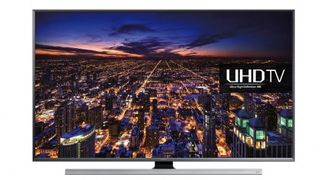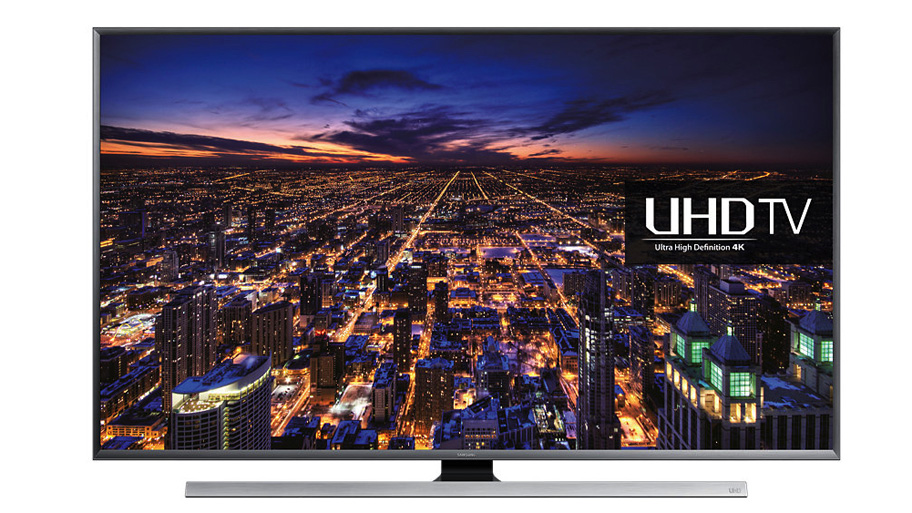Why you can trust TechRadar
Even without the high brightness, wide colour gamut panels used in Samsung's JS9500 and JS9000 HDR TVs, I was fully prepared to love the picture quality of the UE48JU7000T - especially given the much more digestible price you're getting it for.
But, to my surprise, first impressions of this Samsung TV's pictures were hugely disappointing.
The reason for this is the extent to which its key UHD resolution is damaged by unexpected motion blur. Whenever there was any substantial motion in the frame I couldn't help but notice the moving parts of the picture lost considerable amounts of resolution. And even at times left a trail behind as the screen apparently failed to refresh itself fast enough to keep up with the changes in the image content.
This sort of thing used to be a common problem caused by sluggish LCD panel response times, but it's not something I see to this degree much these days, especially on relatively high end TVs. It's also not a problem I associate at all with high-end Samsung TVs.
Very weird.
Thinking it could be a problem related to the TV's motion or noise reduction processing, I turned both these systems off completely. But it didn't make any difference. Then I tried turning off the dynamic contrast and local dimming features on the off chance they were to blame. No change.
Then I tried cranking the motion processing up to its highest setting, but still the motion blur and smearing remained. Same deal if I changed the sharpness and contrast settings.
Next I tried the TV's other picture presets, but again nothing got rid of the problem.
At this point it was tempting to throw in the towel and admit defeat - especially as the amount of legwork I'd already put in would go far beyond what a normal consumer would invest in a new UE48JU7000T. Then I remembered that Samsung had told me a few times its Movie picture preset (the TV defaults to a Standard setting, and it was this I'd been unsuccessfully making adjustments to) automatically turned off a lot of the TV's processing systems.
So I selected the Movie preset again and started working through its associated settings. Nothing much changed until I got to the noise reduction processing options. Turning those off instantly removed almost all traces of the motion - and in doing so, for sundry reasons we'll get to later, turned the UE48JU7000T's pictures from zero to hero.

This is where things get really strange, though.
For even if I copied every single picture setting precisely from the Movie mode to the other picture presets the blurring and motion lag remained painfully obvious. Meaning the only conclusion I could reach was all the picture presets bar the Movie one leave some residual processing in play that you can't turn off and which pretty much destroys picture quality.
Making this situation even more annoying is the fact just choosing the Movie preset and turning off the noise reduction options probably won't be enough to deliver a picture which will satisfy many users.
Even really serious video aficionados focussed on the Rec 709 picture standard (which the Movie mode is designed to deliver) will likely have a problem with, at least, the lack of contrast and the uneven backlighting the Movie mode produces if you only adjust its noise reduction settings.
So many people will have to spend quite some time reworking the Movie preset they're effectively forced to use by the motion problems; doing things like turning on the dynamic contrast feature, activating the local dimming feature for the direct LED lighting system, tweaking the motion processing setting and adjusting the UHD colour setting.
By which point you're probably getting pretty desperate for good news - and wondering why the score attached to this review reads 4.5.
So here you go: once you've finally worked around the motion blur and Movie preset problems, the UE48JU7000T's pictures are actually pretty brilliant.
For starters, once the motion mess has been dealt with the clarity of native UHD pictures is actually gorgeous. There is still a touch of resolution loss over motion versus Samsung's SUHD flagship models, but pictures now always look emphatically UHD in nature.
It does the impression of '4Kness' no harm, either, that Samsung's PurColor is on hand to join forces with all those extra pixels to produce images of spectacular subtlety and finesse.
Stunning contrast
The UE48JU7000T's direct LED lighting system, meanwhile, delivers brilliant contrast performance that combines really outstandingly deep blacks with bold, aggressive colours and strikingly crisp, pure whites - all within the same frame.
No edge-lit LCD TV could deliver nearly the same level of black level purity.
I was pleased to note, too, this dynamism is delivered without causing over-obvious light 'blooms' around the brightest objects, especially if you resist the temptation to push the backlight too high.
It has to be stressed that neither the stretch of the UE48JU7000T's contrast, its brightness, nor the vibrancy of its colours is a rival for the spectacle delivered by Samsung's imperious JS9500 and JS900 TVs. But the UE48JU7000T's pictures are more than competitive with the pictures usually witnessed on sub-£1500 UHD TVs.
The UE48JU7000T's colours look natural as well as punchy, despite not reaching HDR levels of aggression, and the stability of the UE48JU7000T's backlighting when using the provided dynamic contrast system is also very impressive.
With native UHD content still far less plentiful than we'd like it to be, it's a relief to discover that Samsung's UHD upscaling system proves to be superb at adding detail and colour resolution without exaggerating source noise.
Other small issues
There do remain a couple of other minor issues with the UE48JU7000T though, even after you've sorted the initial motion problems out. First, I found its screen quite reflective of any light sources or bright objects in the room. Also, while light blooming from the local dimming system isn't an issue when watching the TV from directly in front, it can creep into the picture if you're watching from an angle of more than 35 degrees or so.
While the lack of any free 3D glasses with the UE48JU7000T might mean many households never get to experience its 3D skills, those skills are actually prodigious. The sense of space from 3D Blu-rays is superb, aided by the screen's excellent contrast and colour handling. While pictures aren't totally free of the crosstalk ghosting noise associated with the active 3D system it occurs rarely and subtly enough to seldom prove distracting.
The UHD detailing of the UE48JU7000T's 3D images helps make 3D worlds feel more tangible too, and strangely I didn't feel as troubled by the TV's motion issues in 3D mode as I was with 2D. The only significant 3D problem really is that 48 inches isn't big enough for a truly immersive 3D experience.
One last impressive aspect of the UE48JU7000T's picture performance is its input lag - or rather, lack of input lag.
My measurements recorded a range of figures between 10 and 30ms, averaging out at around 20ms. This is an excellent effort for any TV, but especially a UHD one that's having to upscale 1080p gaming sources to its 4K pixel count.
John has been writing about home entertainment technology for more than two decades - an especially impressive feat considering he still claims to only be 35 years old (yeah, right). In that time he’s reviewed hundreds if not thousands of TVs, projectors and speakers, and spent frankly far too long sitting by himself in a dark room.

